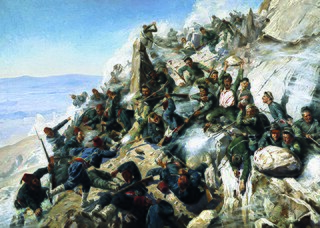This article needs additional citations for verification .(November 2007) (Learn how and when to remove this template message) |
| Battle of Philippopolis | |||||||
|---|---|---|---|---|---|---|---|
| Part of the Russo-Turkish War of 1877–1878 | |||||||
 View of one of the streets of Filipoppol (Plovdiv) after the liberation, January 1878 | |||||||
| |||||||
| Belligerents | |||||||
| Commanders and leaders | |||||||
| Iosif Gurko | Suleiman Pasha | ||||||
| Strength | |||||||
| 12,000 | 7,000 | ||||||
| Casualties and losses | |||||||
| 1,300 killed and wounded [1] | 5,000 killed and wounded, 2,000 captured [2] [3] [1] | ||||||
The Battle of Philippopolis, [4] [5] or Battle of Plovdiv, [6] was one of the final battles of the 1877-1878 Russo-Turkish War.

The Russo-Turkish War of 1877–78 was a conflict between the Ottoman Empire and the Eastern Orthodox coalition led by the Russian Empire and composed of Bulgaria, Romania, Serbia, and Montenegro. Fought in the Balkans and in the Caucasus, it originated in emerging 19th-century Balkan nationalism. Additional factors combined Russian goals of recovering territorial losses endured during the Crimean War, re-establishing itself in the Black Sea and supporting the political movement attempting to free Balkan nations from the Ottoman Empire.
Following the crushing Russian victory at the last battle of Shipka Pass, Russian commander Gen. Joseph Vladimirovich Gourko began to move southeast towards Constantinople. Blocking the route was the Ottoman fortress at Plovdiv under Suleiman Pasha. On 16 January 1878, a squadron of Russian dragoons led by Captain Alexander Burago stormed the city. Its defenses were strong but superior Russian numbers overwhelmed them and the Ottoman forces retreated almost to Constantinople. At this time foreign powers intervened and Russia agreed to the Treaty of San Stefano.

Russia, officially the Russian Federation, is a transcontinental country in Eastern Europe and North Asia. At 17,125,200 square kilometres (6,612,100 sq mi), Russia is the largest country in the world by area, covering more than one-eighth of the Earth's inhabited land area, and the ninth most populous, with about 146.77 million people as of 2019, excluding Crimea. About 77% of the population live in the western, European part of the country. Russia's capital, Moscow, is the largest metropolitan area in Europe proper and one of the largest cities in the world; other major cities include Saint Petersburg, Novosibirsk, Yekaterinburg and Nizhny Novgorod. Extending across the entirety of Northern Asia and much of Eastern Europe, Russia spans eleven time zones and incorporates a wide range of environments and landforms. From northwest to southeast, Russia shares land borders with Norway, Finland, Estonia, Latvia, Lithuania and Poland, Belarus, Ukraine, Georgia, Azerbaijan, Kazakhstan, China, Mongolia and North Korea. It shares maritime borders with Japan by the Sea of Okhotsk and the U.S. state of Alaska across the Bering Strait. However, Russia recognises two more countries that border it, Abkhazia and South Ossetia, both of which are internationally recognized as parts of Georgia.

Constantinople was the capital city of the Roman Empire (330–395), of the Byzantine Empire, and also of the brief Crusader state known as the Latin Empire (1204–1261), until finally falling to the Ottoman Empire (1453–1923). It was reinaugurated in 324 from ancient Byzantium as the new capital of the Roman Empire by Emperor Constantine the Great, after whom it was named, and dedicated on 11 May 330. The city was located in what is now the European side and the core of modern Istanbul.

The Ottoman Empire, also historically known in Western Europe as the Turkish Empire or simply Turkey, was a state that controlled much of Southeast Europe, Western Asia and North Africa between the 14th and early 20th centuries. It was founded at the end of the 13th century in northwestern Anatolia in the town of Söğüt by the Oghuz Turkish tribal leader Osman I. After 1354, the Ottomans crossed into Europe, and with the conquest of the Balkans, the Ottoman beylik was transformed into a transcontinental empire. The Ottomans ended the Byzantine Empire with the 1453 conquest of Constantinople by Mehmed the Conqueror.



















